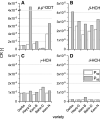Exposure to DDT and HCH congeners and associated potential health risks through khat (Catha edulis) consumption among adults in South Wollo, Ethiopia
- PMID: 33594639
- PMCID: PMC7886647
- DOI: 10.1007/s10653-021-00846-w
Exposure to DDT and HCH congeners and associated potential health risks through khat (Catha edulis) consumption among adults in South Wollo, Ethiopia
Abstract
Khat (Catha edulis) chewing is widespread in the region of East Africa. Even low levels of organochlorine pesticides (OCPs) in khat could induce public health concern. In a market-based study, from five popular khat varieties, a total of 35 composite khat samples were analyzed for dichlorodiphenyltrichloroethane (DDT) and its main transformation products, and four hexachlorocyclohexane (HCH) isomers. Extraction was carried out by quick, easy, cheap, effective, rugged and safe method (QuEChERS). OCP concentrations were determined by head space solid phase microextraction coupled to gas chromatography-mass spectrometry (HS-SPME-GC-MS). Every sample contained β-HCH above the maximum residue limit set by the European Commission. For total DDT, this was the case for 25.7% of the samples. The ratios of (p,p'-DDD + p,p'-DDE) to p,p'-DDT were less than one for 85% of khat samples, demonstrating recent use of DDT in khat farmlands. Conversely, the ratio of β-HCH to total HCH varied from 0.56 to 0.96, implying historical input of technical HCH. Assuming a daily chewable portion of 100 g, dietary intakes of p,p'-DDT, total DDT and total HCH by adults ranged from 3.12 to 57.9, 6.49 to 80.2 and 39.2 to 51.9 ng (kg body weight)-1 day-1, respectively. These levels are below acceptable levels suggested by international organizations. Chewing khat showed lower non-cancer health risk, but showed relatively higher cancer risk in terms of OCPs. Because khat is chewed without being subjected to any treatment, uncertainties associated with estimated intakes and health risks should be low. Therefore, this practice is of great concern.
Keywords: Dichlorodiphenyltrichloroethane; Ethiopia; Gas chromatography–mass spectrometry; Hexachlorocyclohexane; Khat; Organochlorine pesticides; Solid phase microextraction.
© 2021. The Author(s).
Conflict of interest statement
The authors declare no competing interest.
Figures



Similar articles
-
Concentrations and potential health hazards of organochlorine pesticides in (shallow) groundwater of Taihu Lake region, China.Sci Total Environ. 2014 Feb 1;470-471:1047-55. doi: 10.1016/j.scitotenv.2013.10.056. Epub 2013 Nov 14. Sci Total Environ. 2014. PMID: 24239826
-
Organochlorine pesticides and metabolites in young leaves of Mangifera indica from sites near a point source in Coast region, Tanzania.Chemosphere. 2007 Jun;68(5):832-7. doi: 10.1016/j.chemosphere.2007.02.026. Epub 2007 Mar 28. Chemosphere. 2007. PMID: 17395245
-
Evaluation of risk associated with organchlorine pesticide contaminated sediment of the Lake Lianhuan watershed.Ecotoxicology. 2011 Jul;20(5):1090-8. doi: 10.1007/s10646-011-0648-7. Epub 2011 Mar 22. Ecotoxicology. 2011. PMID: 21424718
-
Apparent Khat chewers exposure to DDT in Ethiopia and its potential toxic effects: A scoping review.Regul Toxicol Pharmacol. 2024 Feb;147:105555. doi: 10.1016/j.yrtph.2023.105555. Epub 2023 Dec 22. Regul Toxicol Pharmacol. 2024. PMID: 38142813
-
Concentrations of DDT metabolites in different food items and public health risk in Africa regions: systematic review and metal analysis.Front Public Health. 2025 Apr 2;13:1511012. doi: 10.3389/fpubh.2025.1511012. eCollection 2025. Front Public Health. 2025. PMID: 40241953 Free PMC article.
Cited by
-
Review of scientific literature on available methods of assessing organochlorine pesticides in the environment.Heliyon. 2023 Nov 11;9(11):e22142. doi: 10.1016/j.heliyon.2023.e22142. eCollection 2023 Nov. Heliyon. 2023. PMID: 38045185 Free PMC article. Review.
-
The application of the county medical community HCH model in postoperative nutrition management for patients with advanced gastrointestinal carcinoma.Am J Transl Res. 2023 Mar 15;15(3):2075-2083. eCollection 2023. Am J Transl Res. 2023. PMID: 37056855 Free PMC article.
References
-
- Abbasi-Jorjandi M, Asadikaram G, Abolhassani M, Fallah H, Abdollahdokht D, Salimi F, Faramarz S, Pournamdari M. Pesticide exposure and related health problems among family members of farmworkers in southeast Iran. A case-control study. Environment Pollution. 2020;267:115424. doi: 10.1016/j.envpol.2020.115424. - DOI - PubMed
MeSH terms
Substances
LinkOut - more resources
Full Text Sources
Other Literature Sources
Medical
Research Materials
Miscellaneous

